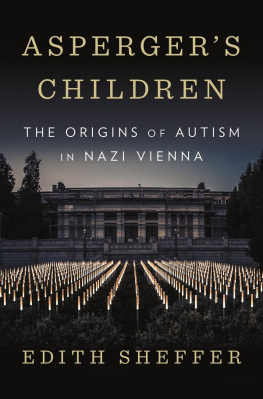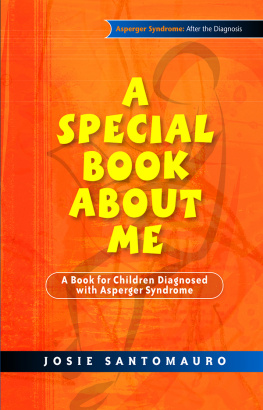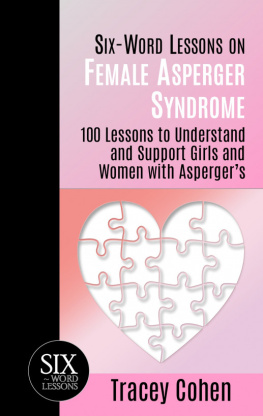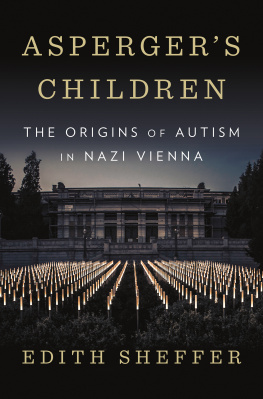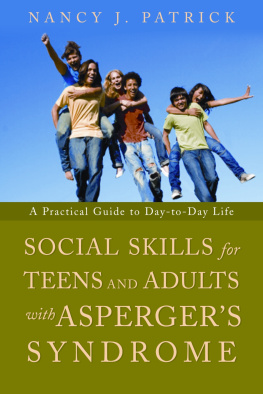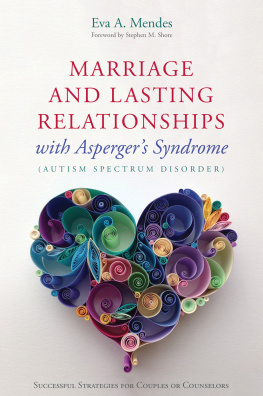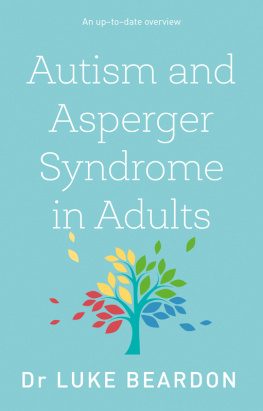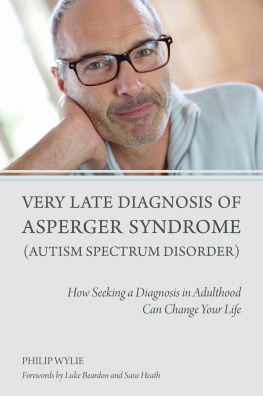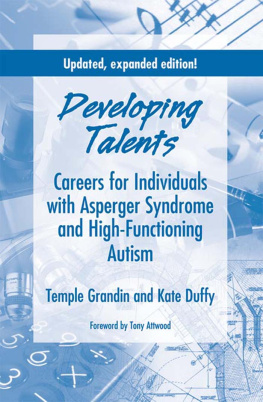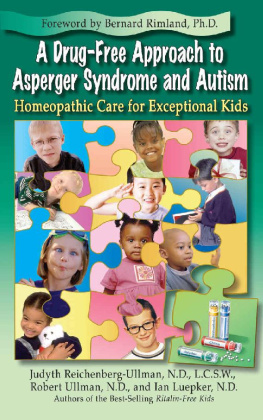ASPERGERS
CHILDREN
The Origins of Autism in Nazi Vienna
Edith Sheffer

To my son,
Eric
CONTENTS
ASPERGERS
CHILDREN
W hat is the difference between a butterfly and a fly? The butterfly does not grow up in the room as the fly does, said Harro. This was his intelligence test. Harro chose to talk about the fly:
It has a completely different development! The fly mother lays many, many eggs in a gap in the floorboards and then a few days later the maggots crawl out. I have read this once in a book,
Harro and other children were growing up in a room, too, cocooned at Hans Aspergers Curative Education Clinic at the
Asperger said he valued the unique characters of the children he treated, tailoring his approach to their individual needs. He had a holistic approach. Children at the elegant and open Widerhofer Pavilion engaged in a range of activities, from sports to drama to music. Asperger sat with the children, his tall frame hunched over to connect with them at their level. With his intent gaze, he noted all realms of their behavior in his postdoctoral thesis. Harro was one of the case studies for his new diagnosis: autistic psychopathy.
Harros school had referred the boy to Aspergers Curative Education Clinic for evaluation. Its report stated that the eight and a half year old seldom did as he was told. Harro talked back, did not do his homework, and complained his lessons were far too stupid. He was His teachers maintained that the boy could succeed if he wanted to. But Harro had failed every subject and was repeating a grade.
He was difficult to test, often uncooperative and unsuccessful in conventional tasks. In certain
The problem, as Asperger saw it, was that Harro did not have social
Asperger decided that Harro demonstrated autistic psychopathy. But because of his intelligence, Harro was on the favorable end of the autistic range. That meant he was capable of remediation and joining was individualized care to nurture their cognitive and emotional growth. He sympathized with their challenges, advocated their potential, and celebrated their uniqueness.
This is the benevolent image of Asperger today. But it represents only one side of Aspergers work. While Asperger did support children he believed to be teachable, defending their disabilities, he was dismissive about those he believed to be more disabled. Deprecatory pronouncements could be a death sentence in the Third Reich. And in fact, some of Aspergers judgments were death sentences.
Although Harro passed Aspergers test, Aspergers label of autistic psychopathy still underestimated the boy. Asperger contended that autistic children did not really fit into this world and looked as if they had just fallen
This is not a story about one boy, however. Nor is it about children on the luckier end of Aspergers autistic range. This book is about all the children who faced the Third Reichs diagnosis regime, and how Nazi psychiatry judged their minds and determined their fates. Diagnoses reflect a societys values, concerns, and hopes. As this book uncovers the nightmarish contexts of autisms creation, it reveals how what today appears to be a singular idea rested upon the community that made it. Aspergers diagnosis of autistic psychopathy emerged from the values and institutions of the Third Reich.
T HE TERM AUTISM was introduced in 1911 by Eugen Bleuler, a Swiss psychiatrist who used it to describe schizophrenic patients who appeared disconnected from the outside world. Hans Asperger and
Kanner, by then based at Johns Hopkins in the United States (where he would be regarded as the father of American child psychiatry) published his work on autism, Autistic Disturbances of Affective Contact, in 1943. 1 in 5,000 in 1975.
Aspergers definition of autistic psychopathy was much broader, and included those he saw with far milder challenges; the children might, for example, have fluent speech and be able to attend a standard school. Aspergers diagnosis remained little known for decades, until leading British psychiatrist Lorna Wing discovered Aspergers 1944 thesis and publicized the diagnosis
The introduction of Aspergers work changed the face of autism in the 1990s. Psychiatrists came to view autism as a spectrum disorder that included children with varying characteristics. The diagnosis expanded from Kanners idea of individuals who he saw as quite disabled, limited in their speech and ability to interact with others, into a personality description that might include math whizzes who were socially awkward.
Rates of autism spectrum diagnoses skyrocketed. While the specific Specialists attribute the increase to a greater sensitivity in recognizing the challenges of children as well as to an objective increase in symptoms.
The American Psychiatric Associations criteria for autism spectrum disorder, while a composite of work conducted by hundreds of psychiatrists, still
Since Aspergers work wound up broadening ideas of an autism spectrum, many laud him for recognizing and celebrating childrens differences. Asperger is often portrayed as a champion of neurodiversity. While the way in which Lorna Wing reintroduced Aspergers 1944 thesis did, indeed, push public discussion toward respecting the uniqueness of individuals, it is time to consider what Asperger actually wrote and did in greater depth, as products of Nazi psychiatry and the world in which he lived.
The aim of this history is not to indict any particular figure, nor is it to undermine the positive discussion of neurodiversity that Aspergers work has inspired. Rather, it is a cautionary tale in service of neurodiversityrevealing the extent to which diagnoses can be shaped by social and political forces, how difficult those may be to perceive, and how hard they may be to combat.
A SPERGER IS OFTEN depicted as compassionate and progressive, absorbed in his research during the Third Reich and opposed to Nazism. He was
The archival record, however, suggests a different story. Files reveal that Asperger participated in Viennas child killing system on multiple levels. He was close colleagues with leaders in Viennas child euthanasia
It is difficult to reconcile Aspergers role in the child euthanasia program with his well-known support for children with disabilities. Both are in the documentary record. Delving into Aspergers work exposes a two-sided nature to his actions. Asperger distinguished between youths he believed to be remediable, who had the potential for social integration, and youths he believed were irremediable. While he offered intensive and individualized care to children he regarded as promising, he prescribed harsh institutionalization and even transfer to Spiegelgrund for children he judged to have greater disabilities. Asperger was not alone. His senior colleagues in Nazi medicine likewise advocated compassionate and first-rate care for children who might be redeemed for the Reich and excision for those they believed to be irredeemable.
The double-sided character of Aspergers actions underscores the double-sided character of Nazism as a whole. The Reichs project to transform humanity involved both treatment and elimination. Depending on the defects, some individuals could be trained to meet Nazi standards, and some were to be eradicated.
It did not take much to define new groups for persecution and death, as inhabitants of the Reich devised and implemented changing labels, rather than a fixed, faceless rulebook, and elastic categories evolved over time. In this diagnosis regime, some people labeled with defects
The efforts of the Third Reich to create a homogenous national community meant bringing people in and multiplying and unifying people the regime deemed desirable, as well as cutting people out. Efforts to cleanse the body politic led to the Holocaustthe killing of over six million Jews in the largest genocide in historyas well as to numerous other programs of systematic elimination. The Reich killed over 200,000 people seen to have disabilities, 220,000 gypsies (Roma and Sinti), and huge segments of eastern European and Soviet populations, including 3.3 million Soviet prisoners of war.
Next page
